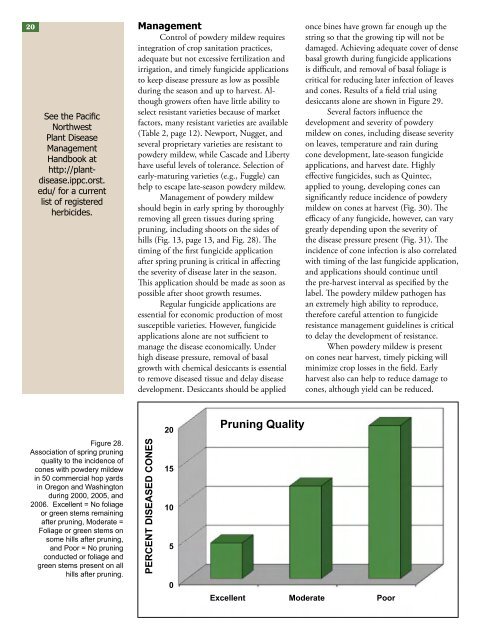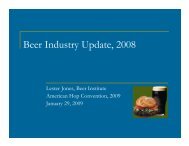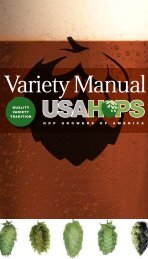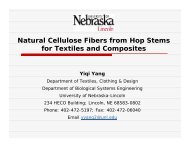Field Guide for Integrated Pest Management in Hops
Field Guide for Integrated Pest Management in Hops
Field Guide for Integrated Pest Management in Hops
Create successful ePaper yourself
Turn your PDF publications into a flip-book with our unique Google optimized e-Paper software.
20See the PacificNorthwestPlant Disease<strong>Management</strong>Handbook athttp://plantdisease.ippc.orst.edu/ <strong>for</strong> a currentlist of registeredherbicides.<strong>Management</strong>Control of powdery mildew requires<strong>in</strong>tegration of crop sanitation practices,adequate but not excessive fertilization andirrigation, and timely fungicide applicationsto keep disease pressure as low as possibledur<strong>in</strong>g the season and up to harvest. Althoughgrowers often have little ability toselect resistant varieties because of marketfactors, many resistant varieties are available(Table 2, page 12). Newport, Nugget, andseveral proprietary varieties are resistant topowdery mildew, while Cascade and Libertyhave useful levels of tolerance. Selection ofearly-matur<strong>in</strong>g varieties (e.g., Fuggle) canhelp to escape late-season powdery mildew.<strong>Management</strong> of powdery mildewshould beg<strong>in</strong> <strong>in</strong> early spr<strong>in</strong>g by thoroughlyremov<strong>in</strong>g all green tissues dur<strong>in</strong>g spr<strong>in</strong>gprun<strong>in</strong>g, <strong>in</strong>clud<strong>in</strong>g shoots on the sides ofhills (Fig. 13, page 13, and Fig. 28). Thetim<strong>in</strong>g of the first fungicide applicationafter spr<strong>in</strong>g prun<strong>in</strong>g is critical <strong>in</strong> affect<strong>in</strong>gthe severity of disease later <strong>in</strong> the season.This application should be made as soon aspossible after shoot growth resumes.Regular fungicide applications areessential <strong>for</strong> economic production of mostsusceptible varieties. However, fungicideapplications alone are not sufficient tomanage the disease economically. Underhigh disease pressure, removal of basalgrowth with chemical desiccants is essentialto remove diseased tissue and delay diseasedevelopment. Desiccants should be appliedonce b<strong>in</strong>es have grown far enough up thestr<strong>in</strong>g so that the grow<strong>in</strong>g tip will not bedamaged. Achiev<strong>in</strong>g adequate cover of densebasal growth dur<strong>in</strong>g fungicide applicationsis difficult, and removal of basal foliage iscritical <strong>for</strong> reduc<strong>in</strong>g later <strong>in</strong>fection of leavesand cones. Results of a field trial us<strong>in</strong>gdesiccants alone are shown <strong>in</strong> Figure 29.Several factors <strong>in</strong>fluence thedevelopment and severity of powderymildew on cones, <strong>in</strong>clud<strong>in</strong>g disease severityon leaves, temperature and ra<strong>in</strong> dur<strong>in</strong>gcone development, late-season fungicideapplications, and harvest date. Highlyeffective fungicides, such as Qu<strong>in</strong>tec,applied to young, develop<strong>in</strong>g cones cansignificantly reduce <strong>in</strong>cidence of powderymildew on cones at harvest (Fig. 30). Theefficacy of any fungicide, however, can varygreatly depend<strong>in</strong>g upon the severity ofthe disease pressure present (Fig. 31). The<strong>in</strong>cidence of cone <strong>in</strong>fection is also correlatedwith tim<strong>in</strong>g of the last fungicide application,and applications should cont<strong>in</strong>ue untilthe pre-harvest <strong>in</strong>terval as specified by thelabel. The powdery mildew pathogen hasan extremely high ability to reproduce,there<strong>for</strong>e careful attention to fungicideresistance management guidel<strong>in</strong>es is criticalto delay the development of resistance.When powdery mildew is presenton cones near harvest, timely pick<strong>in</strong>g willm<strong>in</strong>imize crop losses <strong>in</strong> the field. Earlyharvest also can help to reduce damage tocones, although yield can be reduced.20Prun<strong>in</strong>g QualityFigure 28.Association of spr<strong>in</strong>g prun<strong>in</strong>gquality to the <strong>in</strong>cidence ofcones with powdery mildew<strong>in</strong> 50 commercial hop yards<strong>in</strong> Oregon and Wash<strong>in</strong>gtondur<strong>in</strong>g 2000, 2005, and2006. Excellent = No foliageor green stems rema<strong>in</strong><strong>in</strong>gafter prun<strong>in</strong>g, Moderate =Foliage or green stems onsome hills after prun<strong>in</strong>g,and Poor = No prun<strong>in</strong>gconducted or foliage andgreen stems present on allhills after prun<strong>in</strong>g.PERCENT DISEASED CONES151050Excellent Moderate Poor








